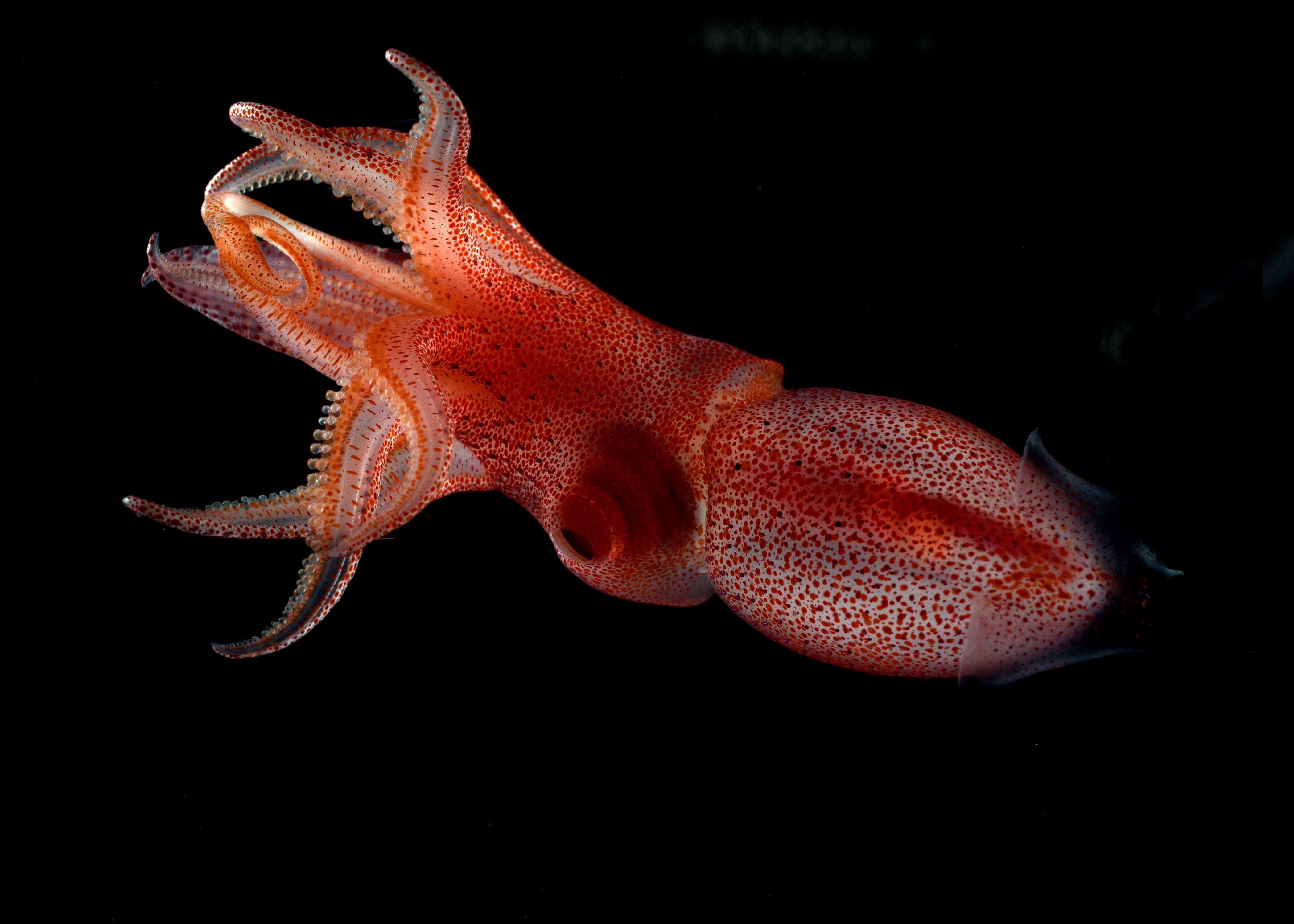Mismatched Eyes Help Squid Survive Ocean’s Twilight Zone
In the deep dark sea, it pays to have eyes that do different jobs
Denizens of the ocean's dim twilight zone, these cockeyed squids have one bulging, orb-like eye to spot the shadows of other creatures against the fading sunlight, and a smaller eye to catch flashes from bioluminescent creatures.
From eyes the size of basketballs to appendages that blink and glow, deep-sea dwellers have developed some strange features to help them survive their cold, dark habitat.
But with one normal eye and one giant, bulging, yellow eye, the “cockeyed” squid Histioteuthis heteropsis has perhaps the strangest visage of all.
 “You can’t look at one and not wonder what’s going on with them,” said Duke University biologist Kate Thomas.
“You can’t look at one and not wonder what’s going on with them,” said Duke University biologist Kate Thomas.
By watching cockeyed squids glide and pirouette through more than 150 undersea videos collected by the Monterey Bay Aquarium Research Institute (MBARI), Thomas has gathered the first behavioral evidence that the squids’ lopsided eyes evolved to spot two very different sources of light available in the deep sea.
These observations, combined with visual simulations, indicate that the large eye is specifically adapted for gazing upwards, searching for shadows of fellow sea creatures against the rapidly fading sunlight, while the small eye is adapted for gazing downwards, scanning deeper, darker water for flashes of bioluminescence.
“The deep sea is an amazing natural laboratory for eye design, because the kinds of eyes you need to see bioluminescence are different from the kinds of eyes you need to see the basic ambient light,” said Sönke Johnsen, professor of biology at Duke University and senior author on the study. “In the case of the Histioteuthis, this cockeyed squid, they chose one eye for each.”
The results are published online Feb. 13 in a special issue of the journal Philosophical Transactions B.
Also known as the strawberry squid for its bright pink color and smattering of seed-shaped photophores, Histioteuthis lives in a region of the ocean known as the mesopelagic or “twilight” zone, 200 to 1000 meters below the surface.
What meager light reaches these depths is extremely dim, a monochromatic blue, and travels straight down from above. Often, the bioluminescent flashes of other sea creatures -- which could signal danger or potential prey -- are brighter than the ambient sunlight.
Since their discovery over a century ago, cockeyed squids’ mismatched eyes have puzzled biologists.
To gain insight into their behavior, Thomas, a graduate student in Johnsen’s lab and lead author on the paper, combed through 30 years of videos collected by MBARI’s remotely operated vehicles (ROVs), which documented 152 sightings of Histioteuthis heteropsis and nine sightings of its similar but rarer cousin, Stigmatoteuthis dofleini.
She found that these “lazy, slow-moving” squid prefer to drift through the sea in a pose that might appear upside-down to us land-lubbers -- head down and tail up -- but nearly vertical, with the big eye consistently oriented upwards, and the small eye consistently oriented downwards.
Using visual simulations, Thomas showed that, because the sunlight only comes from directly above, it would be nearly impossible for an eye angled downwards to spot silhouettes against the ambient light. Similarly, while increasing the size of an upward-facing eye a small amount greatly improves its sensitivity to dim sunlight, increasing the size of a downward-facing eye has little impact on its ability to spot bioluminescent flashes against a dark background.

Histioteuthis heteropsis or "strawberry squid" as photographed by Kate Thomas.
“The eye looking down really only can look for bioluminescence,” Johnsen said. “There is no way it is able to pick out shapes against the ambient light. And once it is looking for bioluminescence, it doesn’t really need to be particularly big, so it can actually shrivel up a little bit over generations. But the eye looking up actually does benefit from getting a bit bigger.”
Sporting two gigantic eyes may seem like the ultimate strategy for surviving the deep dark sea. But where resources are sparse, the cockeyed squid may have stumbled upon an ingenious solution to an ocular conundrum, Thomas said.
“Eyes are really expensive to make and maintain,” Thomas said. “You want eyes just big enough to do what you need to do, but you don’t want to have any bigger eyes because then you are just wasting resources.”
This research was supported by the David and Lucile Packard Foundation. Thomas also received support from a National Science Foundation Graduate Research Fellowship (NSF DGF 1106401) and a Duke Graduate School travel award.
CITATION: "Two eyes for two purposes: in situ evidence for asymmetric vision in the cockeyed squids Histioteuthis heteropsis and Stigmatoteuthis dofleini," Kate Thomas, Bruce Robison and Sönke Johnsen. Philosophical Transactions B, Feb. 13, 2017. DOI: # 10.1098/rstb.2016.0069